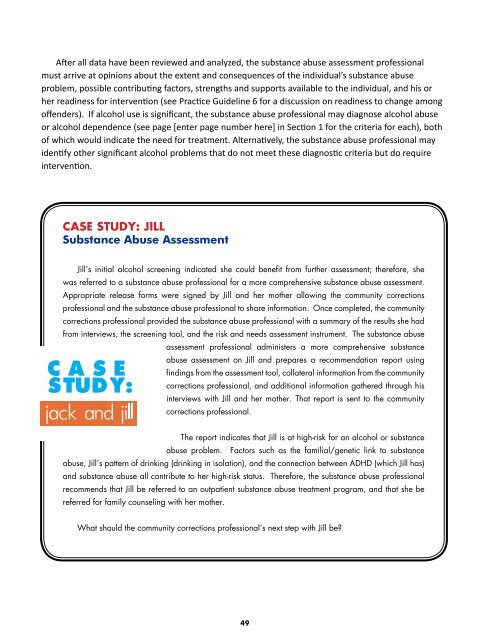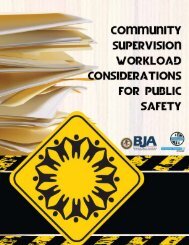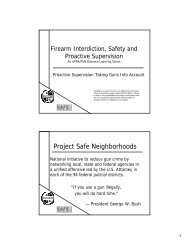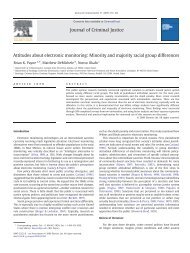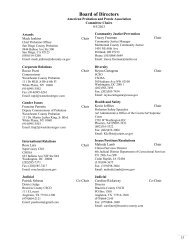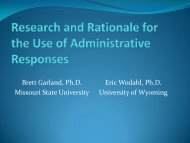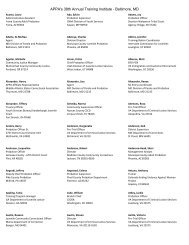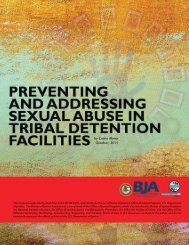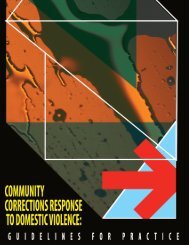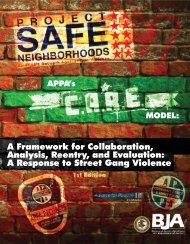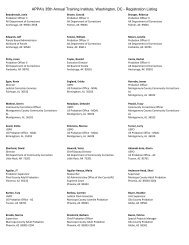Intervention Principles and Practice Guidelines for - Underage ...
Intervention Principles and Practice Guidelines for - Underage ...
Intervention Principles and Practice Guidelines for - Underage ...
You also want an ePaper? Increase the reach of your titles
YUMPU automatically turns print PDFs into web optimized ePapers that Google loves.
After all data have been reviewed <strong>and</strong> analyzed, the substance abuse assessment professional<br />
must arrive at opinions about the extent <strong>and</strong> consequences of the individual’s substance abuse<br />
problem, possible contributing factors, strengths <strong>and</strong> supports available to the individual, <strong>and</strong> his or<br />
her readiness <strong>for</strong> intervention (see <strong>Practice</strong> Guideline 6 <strong>for</strong> a discussion on readiness to change among<br />
offenders). If alcohol use is significant, the substance abuse professional may diagnose alcohol abuse<br />
or alcohol dependence (see page [enter page number here] in Section 1 <strong>for</strong> the criteria <strong>for</strong> each), both<br />
of which would indicate the need <strong>for</strong> treatment. Alternatively, the substance abuse professional may<br />
identify other significant alcohol problems that do not meet these diagnostic criteria but do require<br />
intervention.<br />
Case Study: Jill<br />
Substance Abuse Assessment<br />
Jill’s initial alcohol screening indicated she could benefit from further assessment; there<strong>for</strong>e, she<br />
was referred to a substance abuse professional <strong>for</strong> a more comprehensive substance abuse assessment.<br />
Appropriate release <strong>for</strong>ms were signed by Jill <strong>and</strong> her mother allowing the community corrections<br />
professional <strong>and</strong> the substance abuse professional to share in<strong>for</strong>mation. Once completed, the community<br />
corrections professional provided the substance abuse professional with a summary of the results she had<br />
from interviews, the screening tool, <strong>and</strong> the risk <strong>and</strong> needs assessment instrument. The substance abuse<br />
assessment professional administers a more comprehensive substance<br />
abuse assessment on Jill <strong>and</strong> prepares a recommendation report using<br />
findings from the assessment tool, collateral in<strong>for</strong>mation from the community<br />
corrections professional, <strong>and</strong> additional in<strong>for</strong>mation gathered through his<br />
interviews with Jill <strong>and</strong> her mother. That report is sent to the community<br />
corrections professional.<br />
The report indicates that Jill is at high-risk <strong>for</strong> an alcohol or substance<br />
abuse problem. Factors such as the familial/genetic link to substance<br />
abuse, Jill’s pattern of drinking (drinking in isolation), <strong>and</strong> the connection between ADHD (which Jill has)<br />
<strong>and</strong> substance abuse all contribute to her high-risk status. There<strong>for</strong>e, the substance abuse professional<br />
recommends that Jill be referred to an outpatient substance abuse treatment program, <strong>and</strong> that she be<br />
referred <strong>for</strong> family counseling with her mother.<br />
What should the community corrections professional’s next step with Jill be?<br />
49


